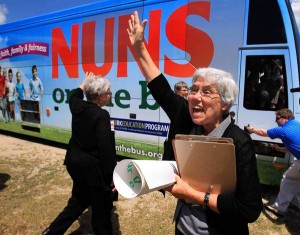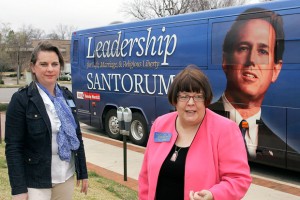Dismantling the Anti-Life Alliance
By Maria Faini
In Marietta, Ohio, on an October afternoon just prior to the recent Presidential election, Tea Party and Catholic protesters confronted Nuns on the Bus, a group of Catholic sisters dedicated to spreading awareness about the social consequences of Paul Ryan’s budget plan. Holding signs with messages such as “Romney/Ryan Yes, Fake Nuns No,” protesters accused Sister Simone Campbell and her fellow nuns of promoting leftist platforms that betray the Catholic Church, specifically antiabortion –or, as they term it, “pro-life”– Catholic doctrine.
 Sister Campbell, however, claimed that the group maintains pro-life advocacy. Sister Monica McGloin told protesters that the organization does not “see focusing on one issue, one point of life,” as the pro-life agenda. Rather, Nuns on the Bus pursues “all social necessities such as living wage, just wage, access to healthcare, education, food, housing, care for seniors, Medicare and other kinds of healthcare programs.” They promote “daycare for children” so parents can maintain jobs; they work to create “healthy, wholesome communities.” For Nuns on the Bus, well-being for all is “what pro-life is.”
Sister Campbell, however, claimed that the group maintains pro-life advocacy. Sister Monica McGloin told protesters that the organization does not “see focusing on one issue, one point of life,” as the pro-life agenda. Rather, Nuns on the Bus pursues “all social necessities such as living wage, just wage, access to healthcare, education, food, housing, care for seniors, Medicare and other kinds of healthcare programs.” They promote “daycare for children” so parents can maintain jobs; they work to create “healthy, wholesome communities.” For Nuns on the Bus, well-being for all is “what pro-life is.”
This confrontation points to a philosophical concern that is pervasive in U.S. politics. Questions of what is considered life and what life is vulnerable enough to warrant help and protection permeate political discourse on topics ranging from health care to climate change. And such questions are never so explosive as with (and within) the abortion debate.
It is also the case that alliances between conservative politics and religious institutions do not map onto the abortion debate in the ways many assume they should and do, and that there remains signfificant intra-group conflict. Not all antiabortionists care about protecting what they see as the most vulnerable lives of our population; their primary focus is control over women’s sexuality. And as Nuns on the Bus demonstrates, not all religious groups, and Catholics in particular, see repealing Roe v. Wade as the sole political end worth pursuing. In fact, like predecessors such as the Religious Coalition for Reproductive Choice, what Nuns on the Bus demonstrates is an ability to reject automatic loyalties between religious groups and conservative politics. They move beyond distracting and misleading disagreements about “life” and “death,” and advocate concern for the well-being of an entire population. In this way, they model how to listen and attend to people’s physical, emotional, and spiritual needs.
These alternative organizations pursue political praxes through which religious and non-religious individuals can work together to promote and protect women and their children. These alliances make greater political advances for families than their “pro-life” counterparts. When life is understood as not just existence but a being’s ability and opportunity to live to full potential—without despair, anguish, or violence—antiabortion-conservative agendas ignore such life. Given their often vicious dismissal of women’s needs, conservative groups instead reflect “anti-life” principles. Indeed, one could term the historical relationship between pro-life and conservative political groups the “anti-life alliance,” acknowledging the ways this relationship harms, rather than helps, families in need. When the abortion debate continues to follow such tired frameworks, productive concepts of life are lost and projects geared toward improving and protecting such life are ignored.
This anti-life alliance is so fundamental to contemporary U.S. politics that significant change seems an impossible goal. The pro-life group Susan B. Anthony List and Penny Nance’s Concerned Women for America consistently join GOP coalitions that call for steep cuts to the social safety net. These groups work tirelessly to define religious ethics as necessarily aligned with fiscal and social conservatism. For example, on November 7th, 2012, GOP interest group leaders held a press conference in which Brent Bozell of Media Research Center and Marjorie Dannenfelser, president of the antiabortion Susan B. Anthony List, faulted the GOP for “a de facto truce on social issues” and called for GOP representatives who will take explicit, aggressive stances against abortion. Their message was simple: the best post-election direction for the party is a decided move away from the center, a stance directly opposed to those politicians who remain interested in “reaching across the aisle” to better serve their constituents.
These antiabortion-conservative agendas limit the prevention of poverty, sickness, despair, and, yes, death—and often meet a nearly impenetrable wall of voter resistance. As long as the anti-life alliance continues, the potential for collaborative public work among pro-choice and antiabortion activists concerned with the well-being of all people is wasted. Shifting the focus from abortion as a practice to the struggles of women facing such reproductive decisions is productive. It is an exercise in communal empathy.
This political move is not against Catholic teaching. Indeed, the Pontifical Council for Justice and Peace makes clear that Catholic social doctrine instructs all people to work towards such a common good. Catholics are asked to follow the teachings of Pope Pius XI who wanted the “distribution of created goods” to “be effectively called back to and brought into conformity with the norms of the common good, that is, social justice” and to avoid a “huge disparity” betwen the “few exceedingly rich and the unnumbered propertyless.” The demands of this common good include a commitment to peace, protecting the environment, and providing “essential services to all” such as “food, housing, work, education and access to culture, transportation, basic health care, the freedom of communication and expression, and the protection of religious freedom.” Catholic doctrine also argues vehemently against race discrimination and violence, while antiabortion agendas disproportionately affect women of color, for whom access to care and control over reproductive health is often a matter of socio-economic survival. The Marietta protests then beg the question: What is wrong, or “fake,” about antiabortion Catholic leaders emphasizing the needs of society’s most vulnerable populations, even at the expense of the abortion debate?
It seems that plenty of people, including Catholics and Christians aware of such nuanced religious doctrines, cannot justify antiabortion accusations, and have been voting accordingly.
Exit polls revealed the unsurprising statistic that “59% of voters think abortion should be legal in the United States, compared to 36% who said it should be illegal.” Indeed, the party that champions antiabortion efforts has lost the popular vote in five of the last six elections. It is true that gerrymandering and other partisan tricks slow the political effects of the population shifts that analysts claim reelected Obama, and the popular vote has remained competitive. But polls and analyses seem to suggest that, over time, national resistance to such GOP principles will not lessen but intensify. As Michael Tanner of The National Review insists, “Republicans haven’t changed” with a changing United States.
This anti-life agenda is one I have witnessed intimately, and my experience points to possible connections between pro-choice and antiabortion sentiments that could work to circumvent the narrow focus on abortion. I grew up in a Roman Catholic community, went to a Catholic grade school, and left the church when I reached adulthood. I had several reasons for leaving, but a primary one was my inability to justify my Church’s political platform. I began to perceive underlying forces at work–specifically sexism and homophobia–and the Church as against, rather than for, my well-being. Yet I never abandoned my childhood experience with the antiabortion movement. I remember listening in Church and school to songs such as Dana’s “Let Me Live,” written from the perspective of an unborn child to her future mother. The child pleads for life with lyrics meant to elicit devastated empathy from women–phrases such as “if you have to choose, choose me …. you cannot know the difference I could make …. we’ve so much to give each other …. as you carry me, so I will carry you.”
Pro-choice advocates see “Let Me Live” as simple propaganda, but dismissing the affective work such songs and images perform is a mistake. Women working to advance the well-being and status of all women miss a critical opportunity for productive empathy when they fail to recognize the palpable grief antiabortion women, and some men, feel for what they see as the plight of unborn children. For them, the unborn are the epitome of vulnerable life; they have visceral reactions to the imagined loss of life they see abortion making possible. Their grief for life is real. An understanding of such grief is a productive political tool.
 Pro-choice activists could learn from listening to their supposed opponents. Discussing Rick Santorum’s influence in the 2012 Republican primaries, Kathy Ferguson recognizes the private and public mourning many antiabortion activists endure. She asks feminists to consider reproductive loss as a possibility for political understanding:
Pro-choice activists could learn from listening to their supposed opponents. Discussing Rick Santorum’s influence in the 2012 Republican primaries, Kathy Ferguson recognizes the private and public mourning many antiabortion activists endure. She asks feminists to consider reproductive loss as a possibility for political understanding:
It is on the terrain of emotional labor, of competing efforts to marshal pity for some victims and contempt for others, that the abortion debates are being fought …. [Antiabortion women are likely to be] motivated more from grief at a loss related to birth or children. The life stories of anti-choice activist women are littered with reproductive losses: devastating miscarriages, infertility, death or serious illness of a child, or some other trauma related to childbearing. [The] conservative evangelical women’s well of birth-grief will not soon wear itself out or retreat from public life.
Pro-choice women struggle over reproductive loss as well. Ferguson suggests that a shared recognition of reproductive grief could “enhance” women’s politics by “taking seriously the disquieting presence of death in life” and “death as a part of life, not its opposite.” Empathizing with such grief is one method through which pro-choice activists might imagine alternative political collaborations.
Yet a collaborative agenda cannot rest on the recognition of this grief alone. If antiabortion advocates wish to represent and protect life, they must understand vulnerable life in its many forms and see such life as worthy of public protection. If antiabortion women see suffering in a fetus, they must also work to see vulnerability in a woman carrying a fetus. They must recognize the ways a raped woman, a single mother without healthcare for herself or her children, a racially profiled teenaged boy, an impoverished immigrant child, and many others are vulnerable and can suffer. And they would work to protect these lives by joining Sister Campbell’s broader pursuit of social welfare.
Ultimately, the notion that antiabortion advocates want only to control women’s sexuality hinders feminists’ efforts in the fight for women. And while not all pro-choice efforts align themselves with broader social justice efforts, many do. They understand the devastating economic and social effects of laws that limit personal behavior and health options. Antiabortionists need to recognize that pro-choice is, of course, not “pro-death.” As Hillary Clinton made clear in a speech to the National Abortion Rights Action League, “Being pro-choice is not being pro-abortion. …. [It] is trusting the individual to make the right decision for herself and her family.” Many voters would benefit from political agendas other than the antiabortion non-choice: simple illegalization of abortion paired with austere platforms that ignore the least fortunate.
 Eliminating women’s choices while refusing to help in other critical economic and social areas is the most destructive answer to the abortion question; simply voting away abortion is a near impossible goal that dismisses the needs of the least fortunate entirely. Many studies have suggested that the best way to ensure a child’s well-being is to do everything possible to enhance the well-being of the primary caregiver. In most cases, this caregiver is the child’s mother. Women must feel economically secure and socially supported, and have adequate health care.
Eliminating women’s choices while refusing to help in other critical economic and social areas is the most destructive answer to the abortion question; simply voting away abortion is a near impossible goal that dismisses the needs of the least fortunate entirely. Many studies have suggested that the best way to ensure a child’s well-being is to do everything possible to enhance the well-being of the primary caregiver. In most cases, this caregiver is the child’s mother. Women must feel economically secure and socially supported, and have adequate health care.
Nuns on the Bus demonstrates a politics that promotes life in ways both (or all) sides might support. Pro-choice and antiabortion groups could accept the necessity of setting aside philosophical arguments about when life technically begins. Instead, they could demand policies that help the plight of people in poverty, struggling within racist social structures, ostracized because of their sexuality, and negotiating political vulnerability because of their illegal status. They could call for healthcare reform that benefits as many women and children as possible, and recognize that government austerity does not help struggling populations, especially during recessions.
The anti-life alliance has been in line with the tradition of violence that, unfortunately, has plagued this country since its inception. Reframing the abortion debate can help us work towards a politics that advances the well-being of all women, children, and families.
____________________________________________
 Maria Faini is a Ph.D. Student and Instructor at the University of California, Berkeley.
Maria Faini is a Ph.D. Student and Instructor at the University of California, Berkeley.




0 comments